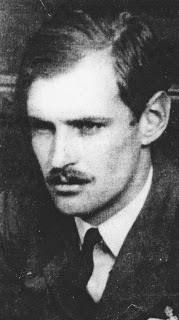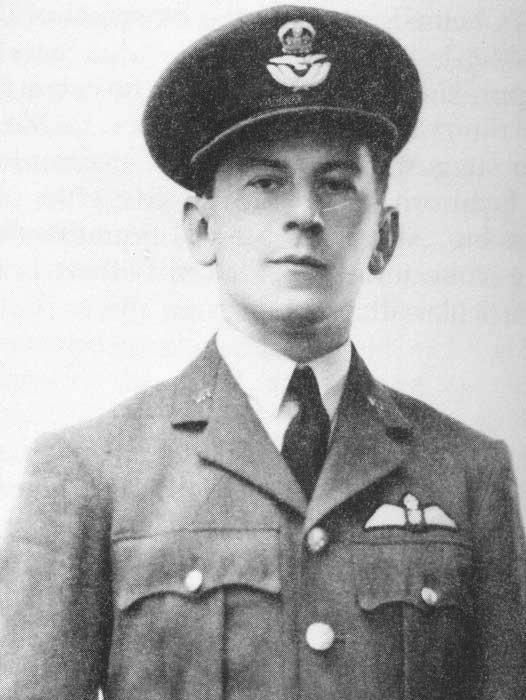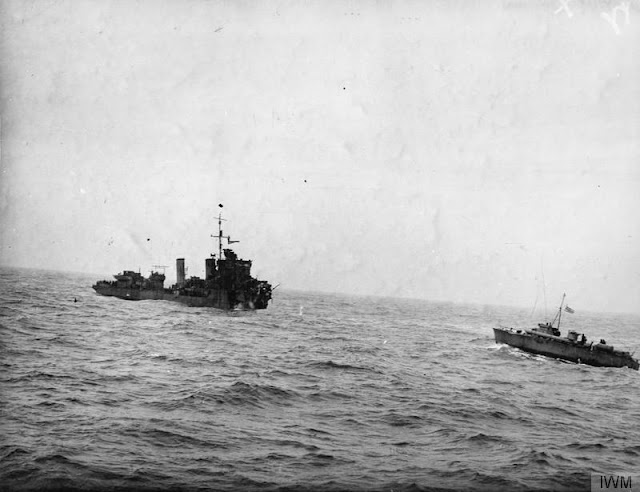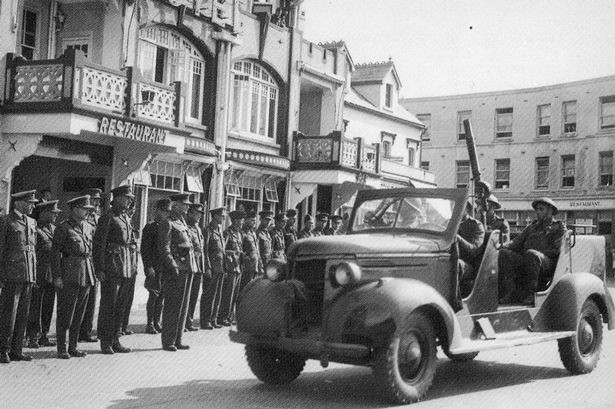Saturday 31 August 1940
 |
| HMS Express after losing her bow to a mine. Photo was taken from HMS Kelvin. © IWM (A 537). |
The main Luftwaffe tactic remains to destroy the RAF in the air and its installations on the ground. Radar stations are subject to attack, but they are a distinctly secondary priority. While cities such as Liverpool are receiving damage, London for the most part has been spared.
As the day dawns, all of the RAF airfields are operational - though Biggin Hill just barely. The raids begin around 08:00, an unusual hour for the Luftwaffe to mount major operations in recent weeks. The RAF gets its fighters into the air earlier than on the 30th, when being too cute with trying to time the raids so that they could be attacked only after the fighter escorts were low on fuel led to a large percent of the bombers getting through to their targets. Two RAF Squadrons head out into pursuit.
However, the first Luftwaffe attack turns out to be a "freie jagd" - fighters without bombers. Air Vice Marshal Keith Park realizes quickly that he has been conned and tells his fighters to return to base - he isn't going to waste them on dogfights. RCAF No. 1 Squadron, though, does not receive the message and loses three planes in a pointless encounter. The Bf 109s, meanwhile, have free reign of the skies otherwise and destroy all 23 barrage balloons over Dover.
A little later, the bombers do appear. This time, Park of No. 11 Group decides to get almost everything he has into the air - he sends up 13 squadrons to attack the formation and keeps three squadrons at home to protect the airfields. Previously, nearby No. 12 Group would have protected his airfields, but after the problems in that area on the 30th, Park is taking no chances.
As is usually the case, the large Luftwaffe formation splits up into numerous smaller formations to attack different targets. Several airfields receive damage, including the vital field at Hornchurch. Duxford is another target, but the tables turn today and No. 12 Group has to call on Park at No. 11 Group for assistance. Park sends over No. 111 Squadron, and they break up that attack.
A third Luftwaffe formation, however, gets through unscathed and hits RAF Debden. Over 100 bombs are dropped on it, causing extensive damage and 18 casualties.
About an hour later, the Luftwaffe sends more planes over the Thames estuary. Eastchurch is hit, along with RAF Detling.
 |
| Pilot James Coward has his foot blown off after his guns jam on 31 August 1940. He manages to bale out, ties a tourniquet around his leg, then has his leg amputated below the knee. |
The other part of the formation attacks Hornchurch again. The defending fighters get a late start again, and the bombers destroy numerous planes on the ground and in the process of taking off.
Another raid an hour or two later targets radar station at Foreness. This raid does not get any lucky hits, as on the 30th, so the stations remain operational.
At 15:15, another attack comes across over the Thames estuary. Hornchurch suffers again, and Biggin Hill takes more damage. The Dornier Do 17s are carrying heavy 1000lb bombs. A direct hit on the Operations Room roof destroys the plotting room, and there is extensive damage elsewhere.
The attacks continue into the night. Liverpool is hit again, Bristol receives some damage, but the damage to Liverpool is significant (20 civilians killed in a shelter that gets a direct hit). A trawler in the harbor is hit, the gas works at Birkshaw Lane is damaged, and numerous shops and flats are destroyed.
During a Luftwaffe attack on Birkenhead, the Royal Navy battleship Prince of Wales is damaged by a near miss. British tanker British Energy also is damaged there, while British tanker Athelviscount is damaged in the River Mersey near Liverpool.
This is considered to be the nadir for the RAF during the Battle of Britain. More flying personnel are killed or wounded, and the RAF loses its greatest number of planes in one day (30-40). The Luftwaffe loses roughly the same number of planes. More ominously for the RAF, it loses 14 pilots.
This rate of exchange highly favors the Luftwaffe, particularly when you add in all the damage being caused to RAF infrastructure and the country at large. The British media, of course, is full of its usual wild tales of Luftwaffe losses approaching triple figures. If all such claims over the month of August 1940 were tallied and reflected reality, the Luftwaffe would be out of planes already. As it is, Luftwaffe losses are higher than RAF losses when everything is accounted for - but not by much.
As a result of the day's events, RAF No. 610 Squadron is transferred out of Biggin Hill to Acklington for a rest, and No. 72 Squadron replaces it.
 |
| RAF Pilot Officer Gerard H "Gerry" Maffett, KIA 31 August 1940. |
The invasion scare turns out to be a false alarm, but the damage to the destroyer is about as bad as if it had turned out to be real. Destroyer HMS Express is the first one to hit a mine off Texel. The mine hits near "B" gun forward, and it blows off the entire bow. The Express losses 59 crew in the explosion
Destroyers HMS Esk and Ivanhoe then close to help the Express, while the remaining two destroyers retrace their route out of the minefield. Esk then hits a mine, then Ivanhoe hits one. There now are three destroyers dead in the water. Esk then hits another mine that detonates her magazine, sinking the ship quickly. There are 136 dead and two survivors.
The Express and Ivanhoe now are left, badly damaged, in the middle of the minefield. Express, saved only by watertight doors underneath the bridge, goes into reverse to get out of the minefield and relieve pressure on the strained bulkhead - the only thing keeping her afloat.
The Admiralty dispatches motor torpedo boats, which take off the crew of the Express. After resolving several problems with the tow, the Express makes it to Hull for repairs at Chatham Dockyard. The Ivanhoe attempts the same maneuver as the Express, but something happens to her propeller or driveshaft and she is dead in the water.
Eventually, the Luftwaffe takes an interest, and the British have to scuttle the Ivanhoe. Thus, the British lose two destroyers and have a third out of action for an indefinite, but obviously very long, period. The Luftwaffe rescues 24 men from the Ivanhoe and makes them POWs.
 |
| HMS Express, her bows blown clear off by a German mine, as seen from HMS Kelvin. © IWM (A 534). |
U-59 (Joachim Matz) continues its successful patrol northwest of Ireland. At 02:06, it sends two torpedoes into and sinks 4616-ton British collier Bibury. All 39 men on board perish. The Bibury had just dispersed with two other ships from Convoy OB 205. The ship sinks in five minutes. This sinking remained a mystery for some time due to the lack of any survivors - it just vanished.
U-38 (Kptlt. Heinrich Liebe), toward the end of her sixth patrol and operating out of Wilhelmshaven, stalks Convoy OB 225 as it departs the British Isles for the United States. Spotting a straggler - always easy prey - northwest of County Donegal, it torpedoes and sinks 2508 ton British fertilizer freighter Har Zion. There is only one survivor, seaman Osman Adem, and the other 35 men on board perish. After this, U-38 heads for her new home port of Lorient.
U-60 (Oblt.z.S. Adalbert Schnee) is on her eighth patrol several hundred miles off Malin Head, Northern Ireland. While not an unlucky boat, she has few kills under her belt, and that string continues. At around 2300, Schnee sends two torpedoes at 15,434-ton Dutch passenger liner Volendam. One of the torpedoes explodes, but the large liner survives likely due to watertight doors. After the crew and passengers (878 total onboard) are taken off (one death), she is towed to the Clyde by the salvage tug Salvonia. During repairs, the workers find the second torpedo in the hull, unexploded - a very lucky break for the liner.
U-46 (Kptlt. Engelbert Endrass) stalks Convoy OB 205 about 100 miles northwest of Barra Head, Scotland. It torpedoes and sinks the 7461-ton Belgian freighter Ville de Hasselt. Everyone on board survives.
 |
| A British motor torpedo boat goes to the assistance of HMS Express after it has had its bow blown off due by a German mine. © IWM (A 535). |
Dutch 175-ton freighter Marne, carrying a load of ammunition and copper pipe, hits a mine and sinks off the Tyne. The mine blows the ship to pieces and it sinks completely within three seconds with the loss of three crewmen in the hold. Captain Stam and the mate are thrown clear and survive.
Royal Navy 43 ton armed yacht HMY Emelle disappears. This is one of those mystery sinkings about which virtually nothing is known.
The Kriegsmarine lays minefield SW 3 in the western Baltic.
A major troop convoy departs from Britain for Freetown under heavy escort. It carries 8,000 British and French troops for undetermined operations in Africa. The ultimate destination turns out to be Dakar, but this is not known yet - Dakar remains under Vichy control. These are the opening moves of Operation Menace.
Convoys OA 207 and MT 156 depart from Methil, Convoy FN 268 departs from Southend, Convoy FS 268 departs from the Tyne.
U-95 (Kapitänleutnant Gerd Schreiber) is commissioned.
For the month of August, shipping losses are:
- 84 Allied ships lost 353,004 tons in the Atlantic;
- 8 Allied ships lost 44,225 tons in the Mediterranean, Indian and Pacific Oceans;
- 4 Axis ships 10, 064 tons in the Mediterranean;
- 3 U-boats lost, 28 remain in the Atlantic.
 |
| A Stuka brought down on 31 August 1940. |
As part of the diversionary scheme, Royal Navy aircraft from HMS Ark Royal bomb Sardinia. Destroyers are sent in that direction (Operation Squawk) to mislead the Italians into thinking that an attack on Genoa is the objective.
The Italians lightly damage Polish destroyer Garland.
Admiral Cunningham's force meets up with Admiral Tovey and the 3rd Cruiser Squadron off the southern coast of Greece.
A convoy (MF 2) of three merchant ships with a destroyer escort makes a break for Malta. The Italian air force attacks and damages British refrigerated ship Cornwall. Despite fierce fires caused by three bombs, the crew gets the engines running again and it continues on toward Malta.
Aircraft carrier HMS Eagle spots the Italian battle fleet about 180 miles away from Cunningham's ships in the Aegean. Cunningham heads toward them, but no contact is made during the day. There is a heavy storm during the night.
Elsewhere, the RAF bombs Derna and other Italian positions in Libya.
Italy: The Caproni Ca.331 Raffica (Fire Burst) prototype takes its first flight at Ponte San Pietro at the hands of test pilot Ettore Wengi. The Italians are developing both jet aircraft and biplane planes like this at the same time, and the Raffica is well-designed.
Soviet Union: Upon learning of the Second Vienna Award that resolves territorial disputes between Romania and Hungary, Moscow, apparently miffed at not being involved, launches a diplomatic protest.
China: Chiang Kai-shek appoints Chen Cheng as the new head of the political bureau (propaganda arm) of the Nationalist armed forces.
British Homefront: It is reported that, as of the end of August, over 51,000 British civilians have registered a conscientious objection to serving in the military.
American Homefront: Using his newly granted legal authority, President Roosevelt calls up 60,000 men of the National Guard to serve in the US Army.
A Douglas DC-3 of Pennsylvania Central Airlines crashes near Lovettsville, Virginia. All 25 aboard perish, including US Senator from Minnesota Ernest Lundeen.
The Tizard Mission continues its journey across the Atlantic, while Sir Henry himself is in Washington to coordinate the technology exchange.
Laurence Olivier and Vivien Leigh marry at San Ysidro Ranch, California.
 |
| Queen Wilhelmina's birthday parade near the Esplanade in Porthcawl, Wales, 31 August 1940. That is a Dutch anti-aircraft truck. |
August 1940
August 1, 1940: Two RN Subs Lost
August 2, 1940: Operation Hurry
August 3, 1940: Italians Attack British Somaliland
August 4, 1940: Dueling Legends in the US
August 5, 1940: First Plan for Barbarossa
August 6, 1940: Wipe Out The RAF
August 7, 1940: Burning Oil Plants
August 8, 1940: True Start of Battle of Britain
August 9, 1940: Aufbau Ost
August 10, 1940: Romania Clamps Down On Jews
August 11, 1940: Huge Aerial Losses
August 12, 1940: Attacks on Radar
August 13, 1940: Adler Tag
August 14, 1940: Sir Henry's Mission
August 15, 1940: Luftwaffe's Black Thursday
August 16, 1940: Wolfpack Time
August 17, 1940: Blockade of Britain
August 18, 1940: The Hardest Day
August 19, 1940: Enter The Zero
August 20, 1940: So Much Owed By So Many
August 21, 1940: Anglo Saxon Incident
August 22, 1940: Hellfire Corner
August 23, 1940: Seaplanes Attack
August 24, 1940: Slippery Slope
August 25, 1940: RAF Bombs Berlin
August 26, 1940: Troops Moved for Barbarossa
August 27, 1940: Air Base in Iceland
August 28, 1940: Call Me Meyer
August 29, 1940: Schepke's Big Day
August 30, 1940: RAF's Bad Day
August 31, 1940: Texel Disaster
September 1940
September 1, 1940: RAF's Horrible Weekend
September 2, 1940: German Troopship Sunk
September 3, 1940: Destroyers for Bases
September 4, 1940: Enter Antonescu
September 5, 1940: Stukas Over Malta
September 6, 1940: The Luftwaffe Peaks
September 7, 1940: The Blitz Begins
September 8, 1940: Codeword Cromwell
September 9, 1940: Italians Attack Egypt
September 10, 1940: Hitler Postpones Sealion
September 11, 1940: British Confusion at Gibraltar
September 12, 1940: Warsaw Ghetto Approved
September 13, 1940: Zeros Attack!
September 14, 1940: The Draft Is Back
September 15, 1940: Battle of Britain Day
September 16, 1940: italians Take Sidi Barrani
September 17, 1940: Sealion Kaputt
September 18, 1940: City of Benares Incident
September 19, 1940: Disperse the Barges
September 20, 1940: A Wolfpack Gathers
September 21, 1940: Wolfpack Strikes Convoy HX-72
September 22, 1940: Vietnam War Begins
September 23, 1940: Operation Menace Begins
September 24, 1940: Dakar Fights Back
September 25, 1940: Filton Raid
September 26, 1940: Axis Time
September 27, 1940: Graveney Marsh Battle
September 28, 1940: Radio Belgique Begins
September 29, 1940: Brocklesby Collision
September 30, 1940: Operation Lena
2020
No comments:
Post a Comment